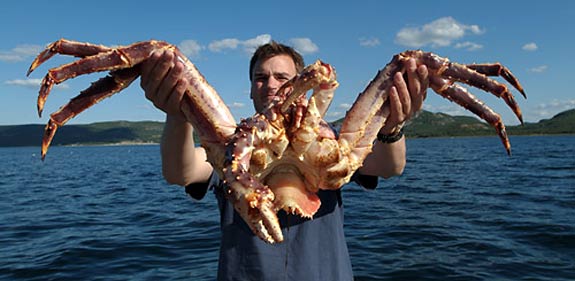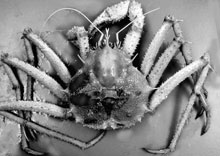December 5, 2009
New Crab Discoveries Total Four

A Varanger king crab is the largest crab species in the world, and is often referred to as the “red king crab.” The family of king crabs just got larger, thanks to some treasures rediscovered, hidden away in a museum “warehouse,” a la’ the end of the first Indiana Jones movie.
Sally Hall, a Ph. D. student at the National Oceanography Centre, Southampton, has discovered four new species of king crab from a pile of untagged specimens at the Smithsonian Collections of the National Museum of Natural History in Washington D.C.
Hall noticed the unidentified specimens while reviewing the Smithsonian collection as part of her doctorate on the evolution of the king crab family, supervised by Dr. Sven Thatje. Some of the specimens were collected more than 100 years ago.
King crabs include some of the largest crustaceans currently inhabiting Earth and are fished particularly from the shallower waters of the polar regions, around the Barents Sea. It’s really surprising that nobody noticed these species before.
~ Sally Hall
The new king crabs, know to biologists as lithodids, are:
Paralomis alcockiana, from the Atlantic Ocean,
Paralomis nivosa, from the Philippines,
Paralomis makarovi, from the Bering Sea, and
Lithodes galapagensis (pictured), the first king crab species recorded off the Galapagos Islands.

Lithodes galapagensis
With the new additions, described this week in Zootaxa, the king crab family now boasts 113 species.
But this might be only the beginning. “The oceans off eastern Africa, the Indian Ocean and the Southern Ocean are all particularly poorly sampled,” says Hall, which means that many other species may remain to be discovered.
Sally Hall and Sven Thatje. “Four new species of the family Lithodidae (Decapoda: Anomura) from the collections of the National Museum of Natural History, Smithsonian Institution.” Zootaxa 2302: 31-47 (2 Dec. 2009)
 About Loren Coleman
About Loren Coleman
Loren Coleman is one of the world’s leading cryptozoologists, some say “the” leading living cryptozoologist. Certainly, he is acknowledged as the current living American researcher and writer who has most popularized cryptozoology in the late 20th and early 21st centuries.
Starting his fieldwork and investigations in 1960, after traveling and trekking extensively in pursuit of cryptozoological mysteries, Coleman began writing to share his experiences in 1969. An honorary member of Ivan T. Sanderson’s Society for the Investigation of the Unexplained in the 1970s, Coleman has been bestowed with similar honorary memberships of the North Idaho College Cryptozoology Club in 1983, and in subsequent years, that of the British Columbia Scientific Cryptozoology Club, CryptoSafari International, and other international organizations. He was also a Life Member and Benefactor of the International Society of Cryptozoology (now-defunct).
Loren Coleman’s daily blog, as a member of the Cryptomundo Team, served as an ongoing avenue of communication for the ever-growing body of cryptozoo news from 2005 through 2013. He returned as an infrequent contributor beginning Halloween week of 2015.
Coleman is the founder in 2003, and current director of the International Cryptozoology Museum in Portland, Maine.
Email • Facebook • Twitter •
Filed under Breaking News, CryptoZoo News, New Species


